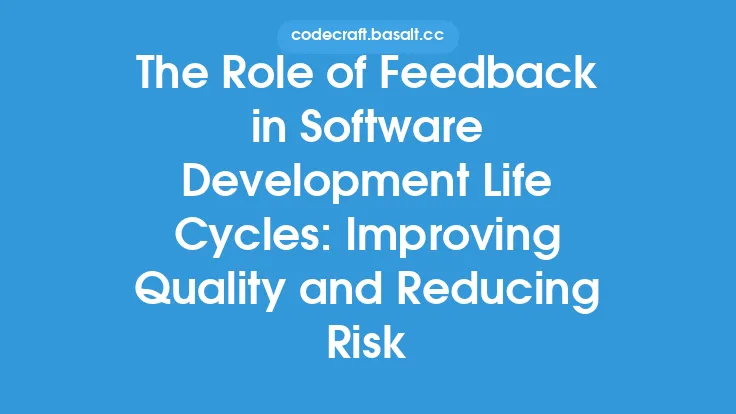In the realm of software engineering, the concept of DevOps has revolutionized the way development and operations teams collaborate to deliver high-quality software products. At the heart of this collaboration lies the importance of feedback loops, which enable teams to continuously improve and refine their processes, ultimately leading to better outcomes. Feedback loops are essential in DevOps as they facilitate the exchange of information between different stages of the software development lifecycle, allowing teams to identify areas for improvement, optimize their workflows, and reduce the time it takes to deliver software changes.
Introduction to Feedback Loops
A feedback loop is a cyclical process where the output of a system is fed back into the system as input, allowing for continuous monitoring, evaluation, and improvement. In the context of DevOps, feedback loops involve the continuous exchange of information between development, testing, deployment, and monitoring stages. This exchange enables teams to identify defects, optimize their workflows, and improve the overall quality of their software products. Feedback loops can be categorized into different types, including internal feedback loops, which occur within a single team or stage, and external feedback loops, which involve multiple teams or stages.
Types of Feedback Loops in DevOps
There are several types of feedback loops that are essential in DevOps, each serving a specific purpose. Internal feedback loops, such as those between developers and testers, help to identify and fix defects early in the development cycle. External feedback loops, such as those between development and operations teams, facilitate the exchange of information about software performance, user experience, and other critical factors. Another type of feedback loop is the feedback loop between the development team and the end-users, which provides valuable insights into the software's functionality, usability, and overall user experience. These feedback loops can be further categorized into manual and automated feedback loops, with automated feedback loops being more efficient and effective in identifying and addressing issues.
Benefits of Feedback Loops in DevOps
The benefits of feedback loops in DevOps are numerous and significant. One of the primary benefits is the ability to identify and fix defects early in the development cycle, reducing the likelihood of downstream problems and improving overall software quality. Feedback loops also enable teams to optimize their workflows, reducing the time it takes to deliver software changes and improving the efficiency of the development process. Additionally, feedback loops facilitate collaboration and communication between different teams and stakeholders, promoting a culture of transparency, accountability, and continuous improvement. By leveraging feedback loops, teams can also improve their ability to respond to changing requirements and user needs, ultimately leading to better software products and improved customer satisfaction.
Implementing Feedback Loops in DevOps
Implementing feedback loops in DevOps requires a combination of technical and cultural changes. From a technical perspective, teams can leverage various tools and technologies, such as continuous integration and continuous deployment (CI/CD) pipelines, monitoring and logging tools, and feedback mechanisms like surveys and user testing. These tools enable teams to automate feedback loops, collect data, and analyze metrics, providing valuable insights into software performance and user experience. From a cultural perspective, teams must adopt a mindset of continuous improvement, embracing feedback and experimentation, and fostering a culture of collaboration and transparency. This requires leadership buy-in, training, and education, as well as the establishment of clear goals, objectives, and metrics for success.
Best Practices for Feedback Loops in DevOps
To get the most out of feedback loops in DevOps, teams should follow several best practices. First, teams should establish clear goals and objectives for their feedback loops, defining what they want to achieve and how they will measure success. Second, teams should leverage automation wherever possible, using tools and technologies to streamline feedback loops and reduce manual effort. Third, teams should prioritize feedback from users and stakeholders, using this feedback to inform product decisions and drive continuous improvement. Fourth, teams should foster a culture of experimentation and learning, encouraging experimentation, learning from failure, and continuous improvement. Finally, teams should regularly review and refine their feedback loops, ensuring that they are effective, efficient, and aligned with changing business needs and user requirements.
Challenges and Limitations of Feedback Loops in DevOps
While feedback loops are essential in DevOps, there are several challenges and limitations that teams may encounter. One of the primary challenges is the complexity of implementing and managing feedback loops, particularly in large, distributed teams. Another challenge is the need for cultural and mindset changes, which can be difficult to achieve, particularly in traditional or siloed organizations. Additionally, teams may struggle with the volume and velocity of feedback, particularly in high-velocity development environments. To overcome these challenges, teams should prioritize simplicity, automation, and cultural transformation, leveraging tools, technologies, and best practices to streamline feedback loops and promote a culture of continuous improvement.
Conclusion
In conclusion, feedback loops are a critical component of DevOps, enabling teams to continuously improve and refine their processes, ultimately leading to better software products and improved customer satisfaction. By understanding the different types of feedback loops, their benefits, and how to implement them, teams can leverage feedback loops to optimize their workflows, improve software quality, and reduce the time it takes to deliver software changes. While there are challenges and limitations to feedback loops, teams can overcome these by prioritizing simplicity, automation, and cultural transformation, leveraging tools, technologies, and best practices to streamline feedback loops and promote a culture of continuous improvement. As the software engineering landscape continues to evolve, the importance of feedback loops in DevOps will only continue to grow, enabling teams to deliver high-quality software products faster, more efficiently, and with greater reliability.





